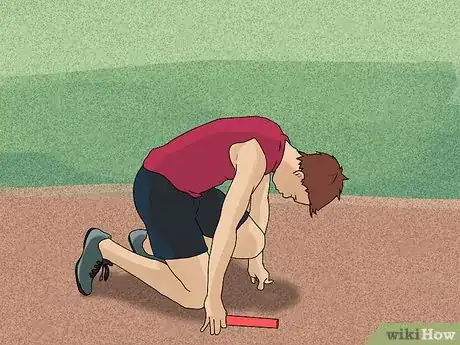This article was co-authored by Kai Ng. Kai Ng is a USATF and RRCA Certified Running Coach at Run Coach Kai. Kai has competed in over 55 races and over 15 marathons, and has trained with 16x USA and World record holder Patti Catalano Dillonso. He specializes in coaching runners of all levels and showing people that everyone can be a runner. Kai is committed to helping his clients reach their goals by showing them how to run with proper form and holding them accountable to train consistently.
There are 14 references cited in this article, which can be found at the bottom of the page.
This article has been viewed 31,972 times.
The 1600 meter track relay, more commonly referred to as the 4x400 meter relay, is one of the most exhilarating and exciting track events. The race consists of four different runners who run one full lap or 400 meters each. Players need to pass a baton to their teammates to initiate the next lap of the race. There are designated lanes for the first lap and the beginning of the second lap, then runners typically fight for the inside tracks.[1] Your team will need to work together, be physically and emotionally ready, and master the correct tactics and strategies in order to be successful in the race.
Steps
Executing the Run
-
1Explode from the start. The opening of the race is incredibly important and contributes to the success of the relay. If you are the first runner in the relay, you will need to set the pace and tempo for the rest of your team.[2] When you begin running, there will be a seven-second timeframe where your body will not have a buildup of lactic acid, and you can take advantage of this to gain speed without getting fatigued.[3] Blast off as fast as you possibly can and then work on gaining more momentum as you run.
- While it may seem like common sense to start slow and then build up speed, this is not the right tactic in the 400-meter relay. You should always be maintaining a speed that's close to a full sprint.
- Train your balance and strength to build up your ability to explode out of the gate.[4]
- Exercises like rocket jumps, truck jumps, lunge jumps, and forward weight throws will help build explosive power for when you need to take off.[5]
-
2Accelerate for the first 100 meters. The first 50-100 meters of your run will be an acceleration period. You should be right below your maximum sprinting speed. The goal here is to pick up enough speed before you go into a more controlled sprint which uses less energy. Don't fall behind the other runners during this stretch of the race.Advertisement
-
3Maintain a steady sprint for the next 100 meters. For the next 100 meters of the contest, you'll want to continue running at near max speed but conserve your energy. You can save your energy by reducing your arm's range of motion.[6]
- Do not reduce your speed or go into a jog. The goal is to maintain the maximum running velocity while conserving your energy.
-
4Re-accelerate again at 200 meters. When you hit 200 meters, you will undergo a rebuilding phase. Build your momentum back up to achieve your maximum speed. Sprint as fast as you possibly can for the last 100-150 meters of the race. In this phase, your body will begin to get tired and want to slow down, but you will lose the race if you do this.
- If you are behind, try to catch up to those ahead of you and exert all the remaining energy that you have for the end of the race.
-
5Use the correct technique. Lift your knees and drive your legs back to generate hip drive.[7] Pump your arms and use your upper body to help you reach maximum speed. Tighten up your sprinting technique during practice by keeping a straight posture and working on the proper breathing technique.
- You will be gassed towards the last leg of the race and your form may deteriorate. Practice drilling your technique so that you maintain it even when you're tired.[8]
- Think of your body like a car. Your upper body is the frame of the vehicle, while your legs are the wheels, and your back leg is the engine.[9]
- Your arms help balance out your body, which helps you maintain your center of gravity.[10]
- Try to stay nice and tall while you sprint.[11]
Mastering the Hand-Off
-
1Pass the baton with your right hand and receive it with your left hand. Typically in the 4x400m relay, the incoming runner is on the inside lane while the outgoing runner is in the outside lane. Once you receive the baton, switch it to your other hand so that you can pass it off to the next runner when you complete your lap.[12]
- The incoming runner is on the inside of the track because it's less distance that they have to run.
- It's really important to focus on the baton transition. It doesn't matter how fast you are; if you don't pass the baton correctly, the whole race goes to waste.[13]
-
2Use a verbal command when passing the baton. Shouting verbal commands like "up," "stick," or "hand" is a common tactic implemented by most track and relay teams. Practice drilling the handoff process, so your team is all on the same page for the verbal command. [14]
- While the 4x400m relay consists of a visual handoff, using verbal commands will improve your timing and make the hand off more fluid.
Advertisement -
3Pass the baton at eye level for your teammate. Your teammates must be able to see exactly where you are placing the baton. They must have the baton in their hand before they can start running .[15] Lift the baton to eye level so the outgoing runner will be able to grab it easily.
- Unlike the 4x100, there are no designated lanes after the second lap in the 1600m relay, so it can get confusing when passing it after the second runner.
- In the 4x100 and 4x200 runners usually use a blind exchange, where teammates only use the verbal command for passing the baton.[16]
- During the pass off it's likely runners will be bumping into each other.
-
4Understand your teammates level of fatigue. A bad handoff is better than no handoff at all. If the baton is dropped or the incoming runner is gassed and slow, it's the outgoing runner's responsibility to turn around and ensure that the baton pass is complete.[17] Examine your teammate and determine their fatigue level. If you need to slow down to accommodate them, delay your acceleration period to complete the pass. Look at your teammates faces and see how much they are slowing down when approaching the pass. If they seem distressed or strained, you may have to go slower out of the gate.
- You can also pick up on teammate tendencies during practice.
- If the baton is dropped, pick it up and resume the race.
Choosing the Best Strategy
-
1Devise a team strategy based on individual strengths and weaknesses. There are a variety of different strategies that a team can use in the 1600m relay. Examine each team member for their strengths and weaknesses and put them in the leg of the race that would be most beneficial for the overall time. Decide whether you want to run from behind and finish strong, or if you want to get a big lead early and maintain it.
- For instance, some teams prefer to put their slowest runners in the third leg of the race, while other teams put their fastest runners in those slots to widen a winning gap.[18]
-
2Choose your best starter to lead off in the race. A common misconception is that the fastest runner should start, but this isn't true. There is a combination of skills that go into being a good starter.[19] For one, they must be good out of the gate, and must be good at pushing off the starting block and avoiding false starts. Starting runners also must be mentally strong because they can't judge their placement in the race during the first lap because of designated lanes and the staggered start of the runners.[20] Combine all these skills together and pick the person on the team that is best at all of them.
- During practice determine the person that is the most capable of launching off the starting block and reaching their maximum speed in a short period.
- A false start occurs when athletes begin to run before the referee initiates the race.[21]
-
3Choose good baton handlers for the second and third runners. Runners in the second and third position must be proficient at handling and receiving the baton, so it's critical that they drill passing it.[22] A bad baton pass could cost your team valuable seconds that could cost you the race, and the second and third runners are the only runners in the race who must exchange it twice.
-
4Choose a strong anchor. The anchor is the last person running in the race and is usually the team's fastest runner. Their goal is to maintain the lead that the second and third runners opened up, or catch up to other teams during the last leg of the race. If you plan on putting weaker runners before the anchor, make sure that the anchor is mature and self-confident enough to catch up to other teams when your team is behind.[23]
-
5Train in long distance running during the offseason. The 4x400 is one of the most grueling long distance sprinting events and requires a good cardiovascular system. Running long distance during the offseason will help you build up your cardio so that you can run at your highest speed for a longer period when you're doing relays. [24]
Community Q&A
-
QuestionHow do you keep your pace when running a mile-long relay?
 Kai NgKai Ng is a USATF and RRCA Certified Running Coach at Run Coach Kai. Kai has competed in over 55 races and over 15 marathons, and has trained with 16x USA and World record holder Patti Catalano Dillonso. He specializes in coaching runners of all levels and showing people that everyone can be a runner. Kai is committed to helping his clients reach their goals by showing them how to run with proper form and holding them accountable to train consistently.
Kai NgKai Ng is a USATF and RRCA Certified Running Coach at Run Coach Kai. Kai has competed in over 55 races and over 15 marathons, and has trained with 16x USA and World record holder Patti Catalano Dillonso. He specializes in coaching runners of all levels and showing people that everyone can be a runner. Kai is committed to helping his clients reach their goals by showing them how to run with proper form and holding them accountable to train consistently.
Certified Running Coach Don't start out too fast. Instead, keep a brisk pace on the first lap and lock in a steady speed on your second and third laps. On your fourth lap, try to empty the tank as much as you can.
Don't start out too fast. Instead, keep a brisk pace on the first lap and lock in a steady speed on your second and third laps. On your fourth lap, try to empty the tank as much as you can.
References
- ↑ https://www.iaaf.org/disciplines/relays/4x400-metres-relay
- ↑ https://spikes.iaaf.org/post/how-to-smash-the-4x4
- ↑ http://trackstarusa.com/how-to-run-the-400m/
- ↑ http://www.bodybuilding.com/fun/tomgreen3.htm
- ↑ http://www.bodybuilding.com/fun/tomgreen1.htm
- ↑ http://trackstarusa.com/how-to-run-the-400m/
- ↑ https://runnersconnect.net/running-injury-prevention/hip-drive-running-stride/
- ↑ https://www.youtube.com/watch?v=TUSmbdkHl0U
- ↑ Kai Ng. Certified Running Coach. Expert Interview. 12 February 2021.
- ↑ Kai Ng. Certified Running Coach. Expert Interview. 12 February 2021.
- ↑ Kai Ng. Certified Running Coach. Expert Interview. 12 February 2021.
- ↑ http://speedendurance.com/2009/03/26/baton-exchanges-how-to-run-the-4x200m-and-4x400/
- ↑ Kai Ng. Certified Running Coach. Expert Interview. 12 February 2021.
- ↑ http://www.humankinetics.com/excerpts/excerpts/keys-to-secure-a-smooth-baton-handoff
- ↑ http://speedendurance.com/2009/03/26/baton-exchanges-how-to-run-the-4x200m-and-4x400/
- ↑ https://www.youtube.com/watch?v=4bc7UFj_RrU
- ↑ http://www.coachr.org/better_baton_passing.htm
- ↑ https://spikes.iaaf.org/post/how-to-smash-the-4x4
- ↑ https://spikes.iaaf.org/post/how-to-smash-the-4x4
- ↑ http://speedendurance.com/2015/03/31/why-i-love-the-4x400m/
- ↑ https://www.washingtonpost.com/news/early-lead/wp/2016/08/16/track-and-fields-one-false-start-rule-is-simply-the-cruelest/
- ↑ http://speedendurance.com/2015/03/31/why-i-love-the-4x400m/
- ↑ https://www.youtube.com/watch?v=4bc7UFj_RrU
- ↑ https://www.youtube.com/watch?v=TUSmbdkHl0U

































































